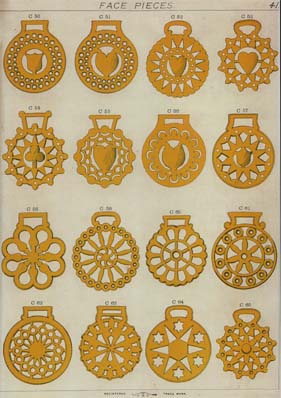Birmingham & Walsall, Pattern Books
R.J. Bradshaw.
Throughout the nineteenth century as the fashion for harness decorations steadily grew, their manufacture became a sizeable industry and although many other smaller foundries across Britain may have had some horse brass output, from the mid-to-late nineteenth century onwards, the manufacture of the largest range of decorative brassware was centred on the areas of Birmingham and Walsall in the West Midlands. The fact that an industry for such things existed here was no mere coincidence as Birmingham had long been an industrial centre specialising in metal goods, mainly due to the fact that the raw materials needed for the production of metals such as water, coal and wood, were all readily available near by
Another reason why the horse brass industry developed in Birmingham was also because there were long-established skills in the working of metals in the area, including several manufacturers that specialised in carriage and harness ware. By 1880, there were dozens of manufacturers established in this area producing a whole range of harness brassware, which is clearly apparent in the surviving examples of manufacturers’ catalogues covered by two NHBS’s publications (see Trade Items).
If a collector is lucky enough to find an original volume however, it will probably be the famous Equine Album, produced by the firm of Hampson & Scott's of Clarence Works, Walsall printed c.1895-1905. This catalogue ran to 260 pages and catered for all the needs of the saddler or horseman. This company not only produced its own wares but acted as a merchanting umbrella for a host of smaller companies whose output was included in their extensive catalogue for dispatch across the British Isles in the late Victorian-early-Edwardian era. Some of the more colourful articles such as the May Day flowers, tapes and fringing were also included in a similar catalogue; Mosemans Illustrated Guide for Purchasers of Horse Furniture and Goods in New York.
Below, Page 41 of Hampson & Scott's Equine Album showing cast Face-pieces available to the horseman.

This was by no means the only catalogue however, and there were many more that also catered for the needs of the horseman including;
Thomas Newton's Saddlery of all Nations catalogue, 1871.
Matthew Harvey, of Walsall 1880, and 1902.
R.E. Thacker of Walsall, The Four in Hand catalogue 1905.
William Overton of Walsall also manufactured brasses, but according to the NHBS publication, Horse Brass Manufacturers Catalogue Illustrations, "Overton was probably best known for his Royal Commemorative brasses, with special leaflets or advertisments at the time of the coronations, rather than general catalogues", (p2.) Such as the example below, taken from Saddlery and Harness, of February 4th 1911. What would any collector give to walk by a shop nowadays and see these on sale in the window! The original plate however, was of course in colour but the one reproduced below, still gives us a clear idea of what was on offer to the patriotic horseman in 1911.
 It is brasses like these that remain as a testament to the skill of the many workers who toiled in this industry; the pattern makers, and casters who worked with the molten metal itself. Then there were the finishers, many of whom were families who worked long hours at home employed as "outworkers". Today however, there is still a flourishing industry for horse brasses, but on a much smaller scale. What is most important though is that these skills are kept alive and although the manufacture of patterns is mainly computerised now, much of the finishing work is still completed by hand and their skill is plainly evident in the brasses that the NHBS produce on a regular basis and give each year to its members as, "Year Brasses" which are now avidly sought by collectors in their own right.
It is brasses like these that remain as a testament to the skill of the many workers who toiled in this industry; the pattern makers, and casters who worked with the molten metal itself. Then there were the finishers, many of whom were families who worked long hours at home employed as "outworkers". Today however, there is still a flourishing industry for horse brasses, but on a much smaller scale. What is most important though is that these skills are kept alive and although the manufacture of patterns is mainly computerised now, much of the finishing work is still completed by hand and their skill is plainly evident in the brasses that the NHBS produce on a regular basis and give each year to its members as, "Year Brasses" which are now avidly sought by collectors in their own right.